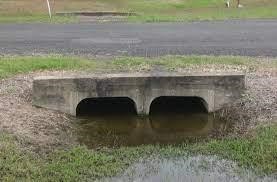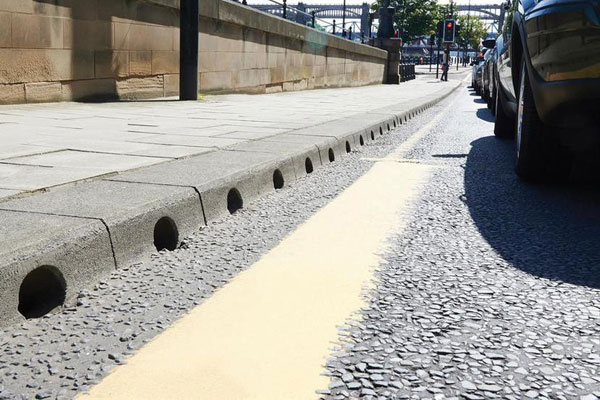The road drainage system is used for the removal and disposal of water from the surface as well as subsurface water. It maintains the stability and durability of the road, by keeping it dry as possible. The longer water sits on a surface, the more susceptible it is to contamination. The installation of suitable surface and sub-surface drainage systems is an essential part of highway design and construction.
Sources of water ingress on roads;
- Capillary action of water
- Rainwater falling on the road surface
- Water accumulated from the surrounding area
- Sub-soil water collection
Why do we need road drainage?
Road drainage systems are installed to capture surface water run-off to alleviate flooding and protect the surface and sub-surface of the road. It is required for the following reasons:
- Prevent flooding, ponding and seepage
- Keep the carriageway, cycleway and footway free of water
- Keep the underlying road structure as dry as possible.
- Prevent damage caused by hazardous surface water
- Stopping surface water flooding adjacent properties
Defects caused due to improper road drainage
The improper highway drainage leads to the deterioration of the road in the form of the following defects:
- The formation of erosion, causing disembarkment along the roadsides
- Dislocation of pavement edge due to the presence of excess water.
- Stripping of bitumen from aggregates like loosening or detachment of some of the bituminous pavement layers
- Formation of potholes
- Failure of soil slopes because excess moisture causes an increase in weight and
- Formation of waves and corrugations in flexible pavements.
- Softening of subgrade soil bearing capacity
- Reduction in soil mass
- Shoulders are pavement edge distress

Requirements of Road Drainage System
Following are the essential requirements of a good highway drainage system:
- The surface water from the carriageway and shoulder should effectively be drained off
- The surface water from the adjoining land should be prevented from entering the roadway.
- The side drain should have sufficient capacity and longitudinal slope to carry away all the surface water collected from the roadway.
- The flow of surface water across the road and shoulders and along slopes should not cause erosion or form cross ruts
- Seepage and other sources of underground water should be effectively intercepted and drained off
- In water-logged areas, special precautions should be taken
- The road surface should be provided with suitable camber to drain off quickly
Types of Road Drainage System;
There are many different types of drainage systems with different design features and attributes that can be used to manage flows and treat water quality. Each of them is discussed below;
1. Surface drainage system

Surface drainage system refers to the drainage wherein surface water is collected and disposed of. It is useful to carry rainwater away from the carriageway. It is applicable in heavy rainfall areas. The water in this drainage system is removed by providing a camber and cross slope to the pavement. The camber and slope depend upon the type of pavement and the intensity of rainfall. This type of drainage system prevents the infiltration of rainwater. includes interception and diversion of water from the road surface. Different types of drainage used for surface drainage systems are;
1- Closed drains
They vary in size and length and can be categorised as:
- Drains provided with gratings
- Jelly drains
2- Ditches or open drains
They vary in size and length and can be categorised as:
- Shallow surface drains
- Medium-sized drains
3- Side drains
4- Catch basins
5- Inlets
2. Subsurface drainage system

Subsurface drainage is used to remove water that has infiltrated into the soil in excess of the amount. It is useful to carry ground water away from the subsoil. It is feasible in water-logging areas. This type of drainage system helps to keep the pavement layers in dry conditions by avoiding a rise in the groundwater table. Different types of drainage used for surface drainage systems are;
- Subgrade Drain
- Longitudinal Drain Trenches
- Subsurface pipes
- Interceptor drains
3. Cross drainage system

Cross drainage is provided whenever streams have to cross the roadway facility. The water from the side drains is also often taken across these structures to divert the water away from the road to a water course or a valley. The need for constructing cross-drainage structures arises to ensure that the water flows beneath the road without causing any inconvenience or instability to the highway structure.
Types of Cross-drainage Structures:
- Box Culverts
- Aqueduct
- Syphon Aqueduct
- Super passage
- Canal Syphon
- Level Crossing
- Canal Inlets and Outlets
- Minor and major bridges
- Causeways
Conclusion
A good road drainage system is an essential part of road infrastructure. Roads need to be well drained to stop flooding, even surface water can cause problems with ice in the winter. Water left standing on roads can also cause maintenance problems, as it can soften the ground under a road making the road surface break up. In this article we have discussed different road drainage types, in an upcoming article series we will discuss in detail of each drainage system type and specification.
Analysis of Road Drainage systems & their features
Sources of water ingress on roads
Why do we need road drainage?
Defects caused due to improper road drainage
Requirements of Road Drainage System
Types of Road Drainage System
Types of Cross-drainage Structures

